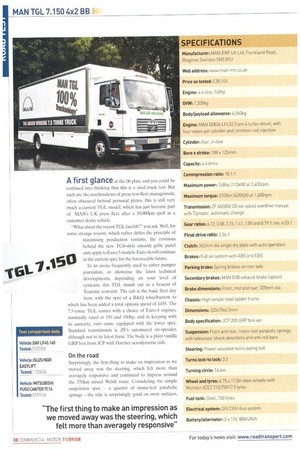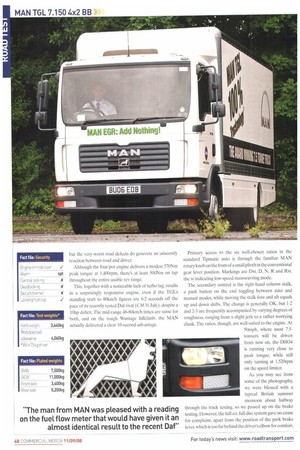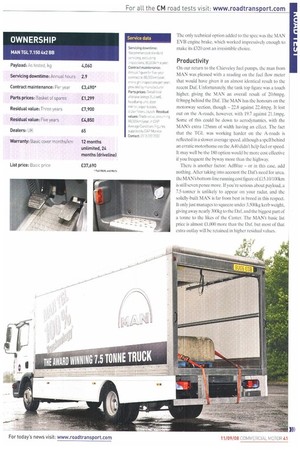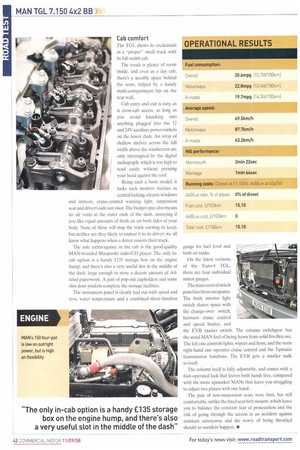A first glance
Page 38

Page 40

Page 41

Page 42

If you've noticed an error in this article please click here to report it so we can fix it.
— at the 06 plate and you could be confused into thinking that this is a used truck test. But such are the machinations of press test-fleet management, often obscured behind personal plates, this is still very much a current TGL model, which has just become part of MAN's UK press fleet after a 30,000Iu-n spell as a customer demo vehicle.
"What about the recent TGL facelift?" you ask. Well, for some strange reason, which rather defies the principle of minimising production variants, the revisions behind the new TGS-style smooth grille panel only apply to Euro-5 models. Euro-As will continue at the current spec for the foreseeable future.
In an arena frequently used to either pamper journalists, or showcase the latest technical developments, depending on your level of cynicism, this TGL stands out as a beacon of Teutonic restraint. The cab is the basic fleet day item, with the spec of a B&Q wheelbarrow to which has been added a total options spend of £455. The 7.5-tonne TGL comes with a choice of Euro-4 engines, nominally rated at 150 and 180hp, and in keeping with its austerity, ours came equipped with the lower spec. Standard transmission is ZF's automated six-speeder, although not in its latest form. The body is a plain vanilla GRP box from JCP with Hatcher aerodynamic aids.
On the road Surprisingly, the first thing to make an impression as we moved away was the steering, which felt more than averagely responsive and continued to impress around the 370km mixed Welsh route. Considering the simple suspension spec a quartet of mono-leaf parabolic springs the ride is surprisingly good on most surfaces. hut the very worst road defects do generate an unseemly reaction between road and driver.
Although the four-pot engine delivers a modest 570Nm peak torque at 1,400rpm, there's at least 500Nm on tap throughout the entire usable rev range.
This, together with a noticeable lack of turbo lag, results in a surprisingly responsive engine, even if the TGL's standing start to 80km1h figures are 6.2 seconds off the pace of its recently tested Daf rival (CM 31 July). despite a 10hp deficit. The mid-range 48-80km/h times are same for both, and on the tough Wantage hillclimb, the MAN actually delivered a clear 10-second advantage. Primary access to the six well-chosen ratios in the standard Tipmatic auto is through the familiar MAN rotary knob on the front of a small plinth in the conventional gear lever position. Markings are Dm, D. N. R and Rm. the m indicating low-speed manoeuvring mode.
The secondary control is the right-hand column stalk, a push button on the end toggling between auto and manual modes, while moving the stalk fore and aft equals up and down shifts. The change is generally OK, but 1-2 and 2-3 are frequently accompanied by varying degrees of roughness, ranging from a slight jerk to a rather worrying clunk, The ratios, though, are well suited to the engine. At 50mph, where most 7.5tonners will be driven from now on, the D0834 is running very close to peak torque, while still only turning at 1,520rpm on the speed limiter.
As you may see from some of the photography, we were blessed with a typical British summer monsoon about halfway through the track testing, so we passed up on the brake testing. However, the full air, full disc system gave no cause for complaint, apart from the position of the park brake lever, which is too far behind the driver's elbow for comfort. The only technical option added to the spec was the MAN EVB engine brake, which worked impressively enough to make its £320 cost an irresistible choice.
Productivity
On our return to the Chieveley fuel pumps, the man from MAN was pleased with a reading on the fuel flow meter that would have given it an almost identical result to the recent Daf. Unfortunately, the tank top figure was a touch higher. giving the MAN an overall result of 20.6mpg. 0.9mpg behind the Dd. The MAN has the honours on the motorway section, though — 22.8 against 22.4mpg. It lost out on the A-roads, however, with 19.7 against 21.1mpg. Some of this could be down to aerodynamics, with the MAN's extra 125mm of width having an effect. The fact that the TGL was working harder on the A-roads is reflected in a slower average speed. although a spell behind an erratic motorhome on the A40 didn't help fuel or speed. It may well be the 180 option would be more cost effective if you frequent the byway more than the highway.
There is another factor: AdBlue — or in this case, add nothing. After taking into account the Daf's need for urea. the MAN'S bottom-line running cost figure of 115.10/100km is still seven pence more. If you're serious about payload, a 7.5-tonner is unlikely to appear on your radar, and the solidly-built MAN is far from best in breed in this respect. It only just manages to squeeze under 3.500kg kerb weight, giving away nearly 300kg to the DA and the biggest part of a tonne to the likes of the Canter. The MAN'S basic list price is almost £1,000 more than the Daf, hut most of that extra outlay will be retained in higher residual values. Cab comfort The TGL shows its credentials as a -propersmall truck with its full-width cab.
The result is plenty of room inside, and even as a day cab, there's a useable space behind the seats, helped by a handy multi-compartment bin on the rear wall.
Cab entry and exit is easy, as is cross-cab access, as long as you avoid knocking into anything plugged into the 12 and 24V auxiliary power sockets on the lower dash. An array of shallow shelves across the full width above the windscreen arc only interrupted by the digital tachogaph, which is too high to read easily without pressing your head against the roof.
Being such a basic model, it lacks such modern niceties as central locking, electric windows and mirrors, cruise-control warning light, su.spension seat and driver's side sun visor. The budget spec also means no air vents at the outer ends of the dash, annoying if you like equal amounts of fresh air on both sides of your body. None of these will stop the truck earning its keep, but neither are they likely to endear it to its driver; we all know what happens when a driver resents their truck.
The sole extravagance in the cab is the good-quality MAN-branded Blaupunkt radio/CD player. The only incab option is a handy £135 storage box on the engine hump, and there's also a very useful slot in the middle of the dash, large enough to store a decent amount of A4sized paperwork. A pair of pop-out cupholders and some slim door pockets complete the storage facilities.
The instrument panel is clearly laid out with speed and revs, water temperature and a combined three-function gauge for fuel level and both air tanks.
On the latest versions of the Euro-4 TGL, there are four individual minor gauges.
The main central switch panel hasthree occupants. The body interior light switch shares space with the change-over switch, between cruise control and speed limiter, and the EVB master switch. The column the usual MAN feel of being hewn from solid Irn-Bru ore. The left one controls lights, wipers and horn, and the main right-hand one operates cruise control and the Tipmatic transmission functions. The EVB gets a smaller stalk switchgear has to itself.
The column itself is fully adjustable, and comes with a foot-operated lock that leaves both hands free, compared with the more upmarket MANs that leave you struggling to adjust two planes with one hand.
The pair of non-suspension seats were firm, but still comfortable, unlike the fixed seat-belt mounts, which leave you to balance the constant fear of prosecution and the risk of going through the screen in an accident against constant annoyance and the worry of being throttled should an accident happen. •












































































































































































